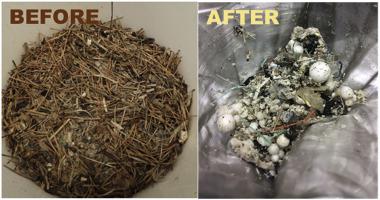Marine Environmental Research ( IF 3.0 ) Pub Date : 2020-07-22 , DOI: 10.1016/j.marenvres.2020.105080 Linn Merethe Brekke Olsen 1 , Heidi Knutsen 2 , Sabnam Mahat 2 , Emma Jane Wade 2 , Hans Peter H Arp 3

|
Identifying and quantifying microplastic in marine samples can be facilitated by removing natural organic matter (NOM). Cellulosic material, like chitin, however, are a type of NOM that is resistant to chemical digestion, and difficult to eliminate from samples. To address this a two-step digestion method was developed to remove or reduce cellulosic materials in diverse marine media to assist microplastic quantification. This method was applied to reference microplastics, reference cellulosic materials, and diverse marine samples from the Inner Oslofjord Norway. This included plankton, seabed sediments near a water treatment plant and driftline sand. The method was developed and tested for plastic particles >45 μm. The first-step was to pre-dissolve cellulosic materials using a mixture of urea:thiourea:NaOH. This was followed by an oxidative digestion using H2O2 and NaOH. Most reference plastics were unaffected, except minor effects for PET and nylon. After sufficient repetitions, cellulosic materials in both reference and marine samples were largely removed. This method was compared to other digestion methods used for microplastic quantification, including single-step oxidation, alkaline treatment, acid treatment and enzymatic treatment. The results indicate that the pre-dissolution step greatly facilitates NOM and cellulose digestion for the purpose of microplastic quantification in marine samples.
中文翻译:

通过在氧化前引入纤维素溶解步骤来促进塑料定量:概念验证和演示,使用来自挪威内奥斯陆峡湾的各种样品。
去除天然有机物(NOM)有助于鉴定和定量海洋样品中的微塑性。但是,纤维素材料(例如甲壳质)是一种NOM,具有抗化学消化作用,很难从样品中消除。为了解决这个问题,开发了一种两步消解方法,以去除或减少多种海洋介质中的纤维素物质,以帮助进行微量塑料定量。该方法用于参考微塑料,参考纤维素材料以及来自挪威内奥斯陆峡湾的各种海洋样品。其中包括浮游生物,水处理厂附近的海底沉积物和流沙。开发了该方法并测试了> 45μm的塑料颗粒。第一步是使用尿素:硫脲:NaOH的混合物预溶解纤维素材料。2 O 2和NaOH。除PET和尼龙的影响较小外,大多数参考塑料均未受影响。经过足够的重复,参比样品和海洋样品中的纤维素材料都被大量去除。将该方法与其他用于微塑料定量分析的消解方法进行了比较,包括单步氧化,碱处理,酸处理和酶处理。结果表明,预溶解步骤大大促进了NOM和纤维素的消化,目的是对海洋样品中的塑料进行定量。











































 京公网安备 11010802027423号
京公网安备 11010802027423号